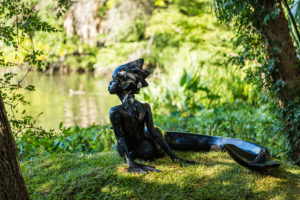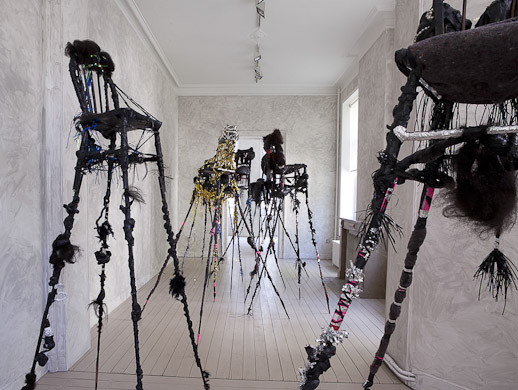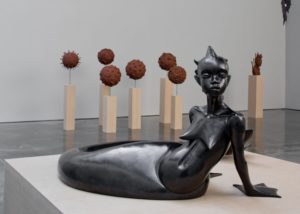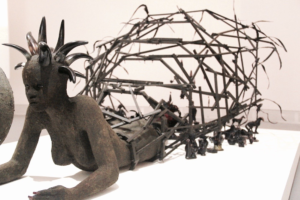
Wangechi Mutu: Sculptures
Water Woman, 2017
About:
In collages, films, sculptures and installations Wangechi Mutu reflects on sexuality, femininity, ecology, politics, the rhythms and chaos of the world and our often damaging or futile efforts to control it. First recognised for paintings and collages concerned with the myriad forms of violence and misrepresentation visited upon women, especially black women, in the contemporary world, Mutu’s work has often featured writhing female forms. Their skin an eruption of buboes, mutant appendices like gun shafts or machine gears sprouting from the sockets of joints, their bodies half human, half hyena, they offer a glimpse at the perversions of the body and the mind wrought by forces active in the oppression of women. More recently, exploring and subverting cultural preconceptions of the female body and the feminine, in her works Mutu proposes worlds within worlds, populated by powerful hybridised female figures. Her practice has been described as engaging in her own unique form of myth-making, one in which the interweaving of fact with fiction opens up possibilities for another group of symbolic female characterisations, markedly different from those that appear in either classical history or popular culture.

Black Thrones, 2012.

Ndoro Na Miti, 2017.
Mutu has worked extensively with Mylar polyester film. Manipulating ink and acrylic paint into pools of colour she carefully applies to her surfaces imagery sampled from disparate sources – medical diagrams, fashion magazines, anthropology and botany texts, pornography, and traditional African arts. The resulting works are a rebuke to the conventions of aesthetics and ethnography and eroticism that underpin such publications, offering instead an existence that is riotously free of biological determinism or psychological conditioning. In recent collage-paintings a substrate of vinyl and linoleum allows for a more densely textured and sculptural ground. Painterly techniques are employed alongside Mutu’s signature construction of images comprised of deftly cut-out and collaged forms. In addition, Mutu’s visual language is further enriched by her use of unexpected materials such as tea, synthetic hair, Kenyan soil, feathers, and sand, amongst other media – many of which are imbued with their own cultural significations.

She’s got the whole world in her, 2015.

The Second Dreamer, 2016
Wangechi Mutu’s work is the subject of a major exhibition at The Contemporary Austin, Texas in 2017. Previous institutional venues for solo shows have recently included the Museum of Fine Arts, Houston (2016); SITE Santa Fe (2016]; the Nasher Museum of Art at Duke University, North Carolina (2013), touring to the Brooklyn Museum of Art, New York (2013), the Museum of Contemporary Art, North Miami (2014), and the Mary and Leigh Block Museum, Northwestern University, Illinois (2014); the Sydney Museum of Contemporary Art, Sydney, Australia, touring to Orange County Museum, California (both 2013); Musée d’art contemporain de Montréal, Montreal (2012); Staatliche Kunsthalle Baden-Baden, Baden-Baden, (2012); Deutsche Guggenheim, Berlin (2010); Art Gallery of Ontario, Ontario (2010); Museum of Contemporary Art, San Diego (2009); and Kunsthalle Wien, Vienna (2008).
This year the artist participates in the Zeitz Museum of Contemporary Art Africa inaugural exhibition, Cape Town (2017 – 2018). Her work was featured at the 56th International Exhibition of Contemporary Art, Venice Biennale (2015), and has been presented in exhibitions at institutions including the Museum of Contemporary Art Chicago (2017 and 2014); Fondation Louis Vuitton, Paris (2017); Studio Museum in Harlem (2017); Tel Aviv Museum of Art (2016- 2017); Fondazione Prada, Milan (2016); Yale University School of Art, New Haven (2016); Museum of the African Diaspora, San Francisco (2016); the Grand Palais, Paris (2015); Museum of the African Diaspora, San Francisco (2015); Louisiana Museum of Modern Art, Humblebaek (2015); Smithsonian National Museum of African Art, Washington, DC (2015 and 2014); Frankfurter Kunstverein, Frankfurt (2014); Centro Cultural Banco do Brasil, Rio de Janeiro (2013); Tate St. Ives, United Kingdom (2013); National Gallery of Canada, Ontario (2013); Kochi-Muziris Biennale, India (2012); Palais de Tokyo, Paris (2012); Brooks Art Museum, Memphis (2012); MOCA, Los Angeles (2010); Vancouver Art Gallery, Vancouver (2010); Tate Liverpool, United Kingdom (2010); 10th Biennale d’art Contemporain de Lyon (2009); and The New Museum, New York (2008). Wangechi Mutu received the 2010 Deutsche Bank Artist of the Year award.(text and courtesy: Victoria Miro, London)
